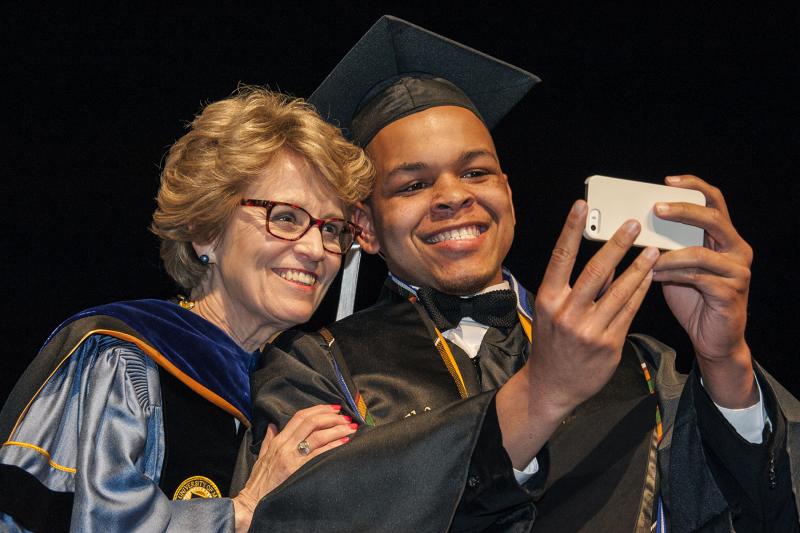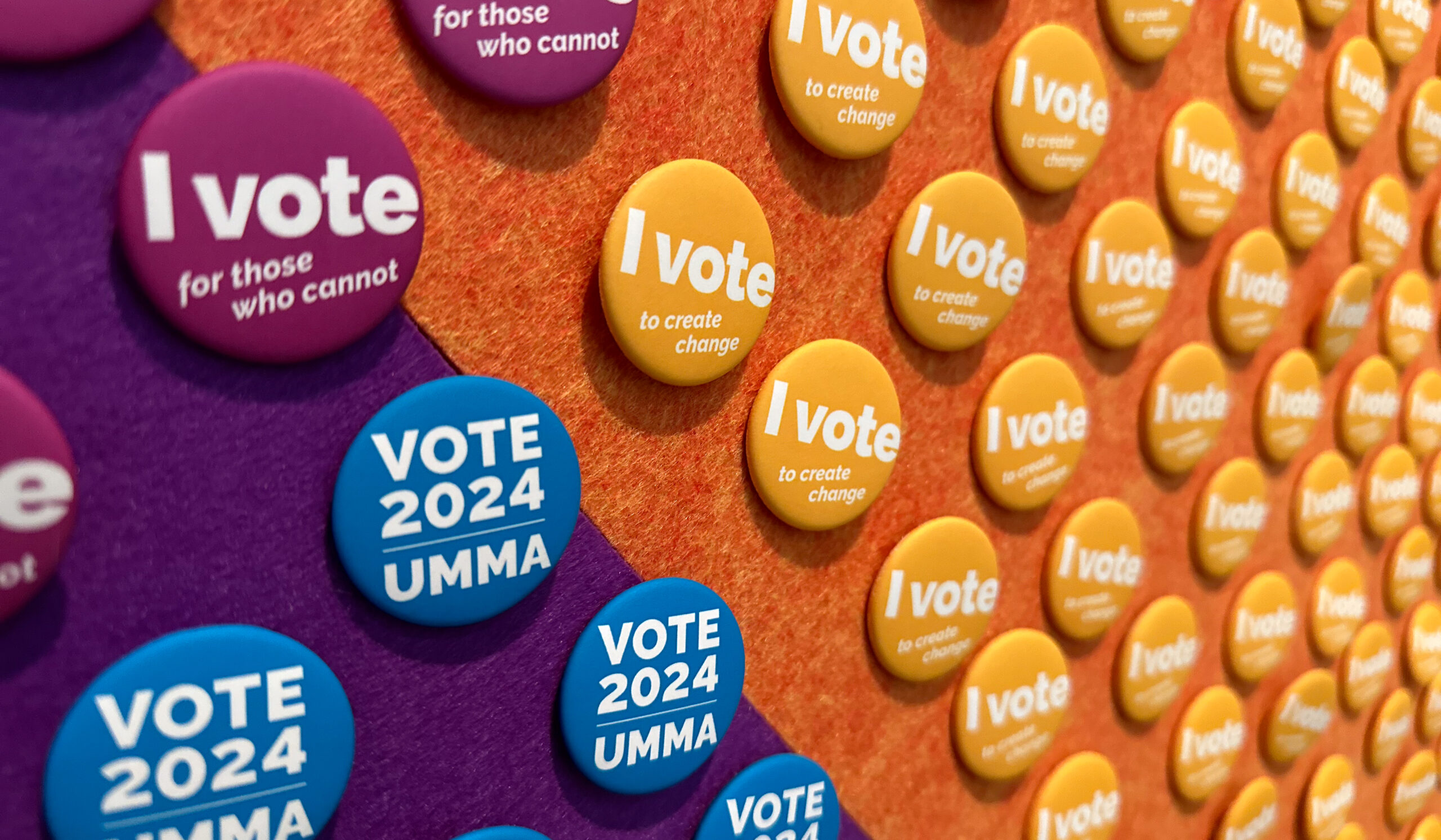This article originally appeared in full in the early fall 2014 issue of Michigan Alumnus magazine.
Student activism, declining enrollment of under-represented minorities, and a U.S. Supreme Court decision have contributed to a new discussion on race at U-M.
“We were the driving force of one of the most groundbreaking moments in student-led activism,” said Grace Sims, ’14, in a six-minute address to her fellow graduates at the 17th Annual Black Celebratory. “I’m sure no one believed that sharing our experiences through Twitter could impact or influence so many around the world.”
Sims referred to perhaps the most modern, highly visible part of the past year’s efforts by activists demanding change on campus: a social media campaign known as #BBUM. That hashtag—short for Being Black at the University of Michigan—was used on Twitter along with statements about their experiences here. The flood of 140-character tales of feeling isolated, slighted, and both intentionally and unintentionally insulted drew media attention after Black Student Union leaders began it on Nov. 19. It even spawned versions by minority students at many other campuses around the country.
The BSU followed up last January on Martin Luther King, Jr. Day with some more old-style activism, including a demonstration decrying the ongoing drop in black enrollment—down to 4.6 percent of students in 2013, from a high of 9.2 percent in 1996 and 1997—and a list of seven demands on the University to improve the experience of those minorities who do attend. Next came weekly meetings with administrators and an announcement in April of a list of moves U-M leaders had agreed to make in coming years.
- $300,000 to renovate the Trotter Multicultural Center and to explore moving it onto Central Campus from its current location on Washtenaw Avenue
- Increase the funds to BSU, which will partner with other groups on campus
- Develop a pilot plan to improve transportation options for students who live outside Ann Arbor
- Provide more funding for students who encounter emergency financial problems
“Understanding Race” was the theme of the 2012-13 winter semester. For months, the campus was awash in speakers, symposia, special classes, and exhibits intended to promote discussion of the issue.
That may have helped set the table, says senior Arnold Reed, BSU’s current speaker. But it was the July 2013 acquittal of Florida neighborhood watch volunteer George Zimmerman in the 2012 shooting death of unarmed teenager Trayvon Martin that was transformative. The BSU organized a candlelight vigil at the Michigan Union that, despite occurring in the dead of summer, drew hundreds of mourners. “After that, it was nonstop,” recalls BSU adviser Elizabeth James, ’82, MA’84. “The kids started talking; they started thinking. I do deeply believe that was the point where all of this started to come together.”
It is, by all accounts, the efforts to improve recruitment of minority students that is the most vexing. Still, Provost Martha Pollack and Regent Mark Bernstein, ’93, MBA’96, JD’96, offered outlines of several approaches in separate interviews this summer. Among those approaches are more aggressive outreach to high schools in lower-income areas as well as an effort by admissions officers to admit less affluent students and students who would be the first in their families to go to college. Another idea involves giving favorable weight to extracurricular activities that involve volunteer work in the inner cities.
“We have and will continue to look for diversity in ways that are legal, that are consistent with the law,” Pollack says. “So, for example, we work very hard at trying to have more socioeconomic diversity. That isn’t a sufficient stand-in for racial diversity, we believe, or ethnic diversity, but it is also an important area.”
The BSU developed a plan for the #BBUM hashtag campaign—testimonies from students describing the experience, both positive and negative, of being black at U-M. The plan was for the stories to lay the groundwork for a Martin Luther King, Jr. Day protest and a list of demands.
Yet in late October, another controversy erupted when the mostly white Theta Xi fraternity advertised a Nov. 7 “Hood Ratchet” party with racially offensive language. The administration canceled the party, and in December the fraternity was sanctioned. But Reed and Sims say the heightened awareness turned a quiet #BBUM launch into an organic online phenomenon. Comments included stories of being the only black person in class and routine encounters with insensitive remarks and ongoing racial profiling.
The attention has prepared Reed, as he returns to campus, to continue to work with the administration, led by incoming President Mark Schlissel. The new president has told anyone who has asked—including representatives of the BSU and other minority student groups in small private meetings— that improving the racial climate and racial composition of the student body is a top priority. And in a July 14 interview with the University Record, he expressed his admiration for the student demonstrations.
“When that group of students came to the regents’ meeting, and sat in the front row with duct tape covering their mouths, and the duct tape said GO BLUE—that really said a tremendous amount to me,” Schlissel told the paper. “It said that even students who have issues that they’re not happy with, and students who fear their voices aren’t being heard, both show their cleverness—by using duct tape—but also their love for the place. I never got a sense that any of the discontent was destructive.”
For her part, James looks ahead both with optimism and fear of dashed hopes. She has attended every one of the Black Celebratory ceremonies and has seen other moments of promising change arise and then vanish. As she sat on the dais listening to Hollins and Sims speak in May, all she could think of was how small a crowd she saw as compared with the late 1990s. Then, the number of black graduates was several times larger and the school seemed well on its way to meeting its diversity aims.
“For me it’s very difficult because I can physically see what’s happened,” she says. “The students used to fill up the main section of the Power Center. Now they’re in just the first four rows. I would expect there would be more by now, not less.”
Steve Friess is an Ann Arbor-based freelance journalist whose work appears in The New York Times Magazine, Buzzfeed, New York magazine, and many others. He was a Knight-Wallace fellow at U-M in 2011-12.





